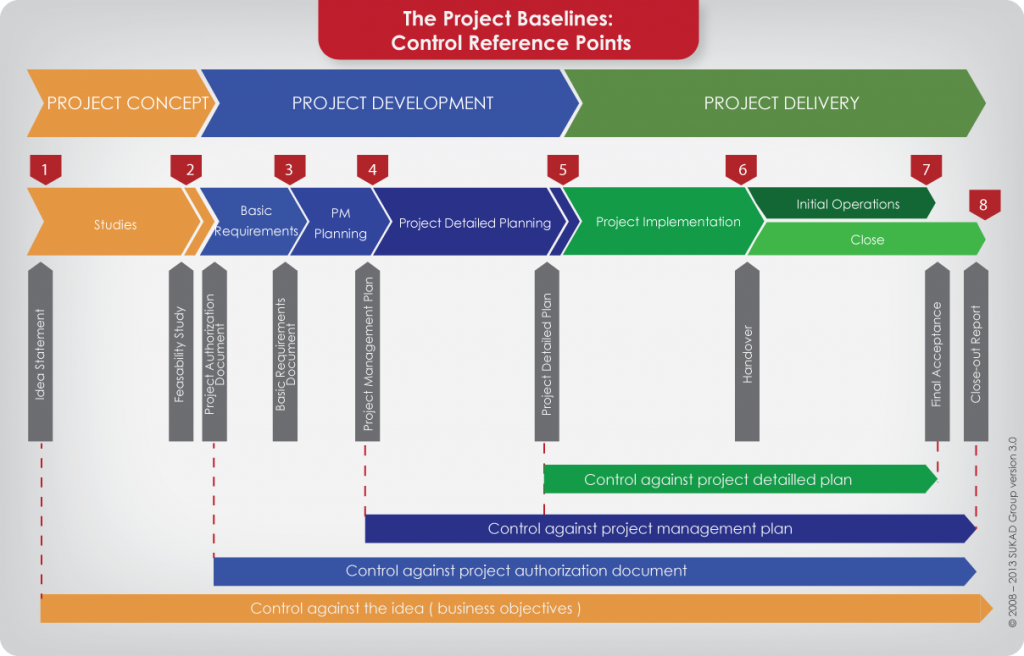Project control is an essential concept in project management, yet, some still do not do well, especially in organizations new to project management. Others – follow traditional project control concepts which might not be enough. In this series we address some of the gaps in practice.
Project Control
CAM2P™ Alternative Perspective
We believe that many organizations use one form or another of the concept that we present in this section, but possibly implicitly, not explicitly.
The proposed approach is that we have ‘moving’ baselines, as we present here, and graphically in the figure. The moving baselines, or what CAM2P™ calls control reference points, start with the idea statement.
Please, it is important to note ‘moving baselines’ does not mean changing the baseline. Changing the baseline refers to the act when an organization re-plans the project and changes the approved plan, which would give a new baseline. By moving, we mean as the project progress from one stage to another, a new control reference points will supersede the previous control reference point.
Well, is not this an example of changing the baseline?
Not really, read on!
First Control Reference Point
In the figure, the lower arrow with the dashed line to idea statement, represents control against the idea – idea statement.
Can we control against the idea?
Yes, we can, although we realize control against the idea is conceptual.
The phrasing of the idea statement is critical, and a slight variation can mean different projects. For example:
- Scenario 1: project purpose is “to get drinkable water from city A to city B”
- Scenario 2: project purpose is “to build a pipeline to get drinkable water from city A to city B”
Clearly, scenario 2 is more specific, and you would expect that the project manager will work on building the pipeline, whereas, in scenario 1, a good project manager will look at all options for moving water and choose the optimal one.
To build on the above, if the project manager in Scenario 2 starts considering options (other than building the pipeline), then she is deviating from the project mandate. On other hand, in Scenario 1 if the project manager is not evaluating options, then she would not be performing her duties properly.
What we are proposing is that the highest-level control on the project is delivering on the idea statement during the pre-launch stage. In other words, this initial control is to ensure that the feasibility study is developed in accordance with the idea statement and does not deviate.
Second Control Reference Point
Control is an ongoing effort that starts with the idea statement, as we already stated. In other words, the idea statement was our first control reference point. The next control reference point is control in comparison to the project authorization document, which is what we show in the second arrow, from the bottom of the figure. Assuming the team performed a proper feasibility study, and the sponsor developed a clear project authorization document, then the second control reference point supersedes the first, because it will encompass its purpose.
For some, this is given and a standard practice. For others, this is a new concept since, as we discussed earlier, various project management approaches stress control against the plan, and the plan is not complete until the end of the planning processes, which some might confuse as stage gate 5.
You may ask, “How can we control against a brief, high level document, such as the PAD?”
The questioning could continue, “There is not enough information to control against at this level; we do not have a baseline yet”.
Our response:
We do have enough to exercise control!
We have the project description, justification, and objectives, all part of the project authorization document, and they are the ultimate control points.
“Aren’t these items vague?”
We agree that they do lack details but if the PAD’s brief contents cannot clearly define the project objectives for us, then it has a deficiency and we have an issue that is likely to impact our project performance. Therefore, control must start as soon as the Sponsor issues the project authorization document.
We do recognize that we might not be able to use the full, earned value management approach at this point, since we do not have quantifiable means for control of the full project, but that is perfectly acceptable. Our main concern during the project development phase is to ensure that we are developing the project in accordance with the project objectives as defined in the PAD.
“What happen if there is a need to change the objectives?”
We can do so via two mechanisms:
- 1. Sponsors can amend the PAD, or
- 2. The organization should have a ‘project change control system’[1] that includes the policy and guidelines on how to initiate and approve changes to the PAD. We call these project objective changes. This would be the recommended approach[2].
One final thought: in the previous chapter, we define the various estimates’ classes, and we placed the Class 1 Estimate as a key requirement for the feasibility study. We also included the project order of magnitude cost and milestone schedule in the project authorization document. As a result, this second control reference point has scope, time, and cost components and can be essentially a preliminary baseline appropriate for the level of detail of the project authorization document.
Part 3 will follow in a couple of days.


Trackbacks/Pingbacks